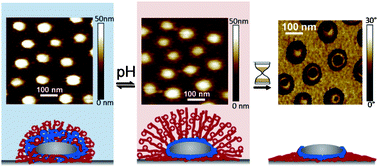We report on a novel approach for the design of stimuli-responsive surfaces based on the immobilization of charged ABC triblock terpolymer micelles. The terpolymer consists of a hydrophobic polybutadiene (B) block, a weak anionic poly(methacrylic acid) (MAA) middle block, and a strong cationic end block of quaternized poly(2-(dimethylamino)ethyl methacrylate) (Dq) (BMAADq). In alkaline solutions, this polymer self-assembles into core–shell–corona micelles with a hydrophobic B core, a pH-sensitive MAA/Dq intramicellar interpolyelectrolyte complex (im-IPEC) shell, and a cationic corona of excess Dq. These micelles were directly adsorbed onto charged silica as a monolayer creating laterally structured surfaces. The adsorption kinetics was found to follow the theoretical model of random sequential adsorption (RSA). Exposure of the adsorbed micelles to external stimuli (at pH < pKa,apparent of PMAA) induces im-IPEC dissolution due to protonation of the MAA block resulting in a changed composition of the shell and both the length and charge density of the corona. Two types of conformational response to pH trigger and therefore, two types of dynamics coupled to short and long relaxation times are involved in the system. The response to pH cycling was shown to be reversible on the short-term scale while the long-term exposure to acidic media causes irreversible changes in the morphology of the micelles as a consequence of the micelles' core mobility and slow rearrangement. In particular, we find that exposure to low pH causes a shape transition to a “doughnut”-like morphology, exposing the core parts of the micelles. In contrast, adsorbed micelles with covalently crosslinked B cores show higher stability to irreversible morphology changes while maintaining the reversible response to pH cycling.

You have access to this article
 Please wait while we load your content...
Something went wrong. Try again?
Please wait while we load your content...
Something went wrong. Try again?


 Please wait while we load your content...
Please wait while we load your content...